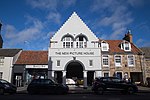Museum of the University of St Andrews
2008 establishments in ScotlandEducation museumsMuseums established in 2008Museums in FifeUniversity museums in Scotland ... and 1 more
University of St Andrews

The Wardlaw Museum is associated with the University of St Andrews. The museum houses a selection of the university's historic, artistic and scientific collections, which comprise over 115,000 artefacts. They are displayed across four galleries which aim to tell the story of the university. The newly refurbished museum now has an extended temporary exhibition space as well as a new research studio and extended gift shop. also contains a 'Learning Loft' for workshops and a viewing terrace with panoramic views over St Andrews Bay.
Excerpt from the Wikipedia article Museum of the University of St Andrews (License: CC BY-SA 3.0, Authors, Images).Museum of the University of St Andrews
The Scores,
Geographical coordinates (GPS) Address External links Nearby Places Show on map
Geographical coordinates (GPS)
| Latitude | Longitude |
|---|---|
| N 56.3429 ° | E -2.794 ° |
Address
Museum of the University of St Andrews (MUSA)
The Scores
KY16 9AR
Scotland, United Kingdom
Open on Google Maps










